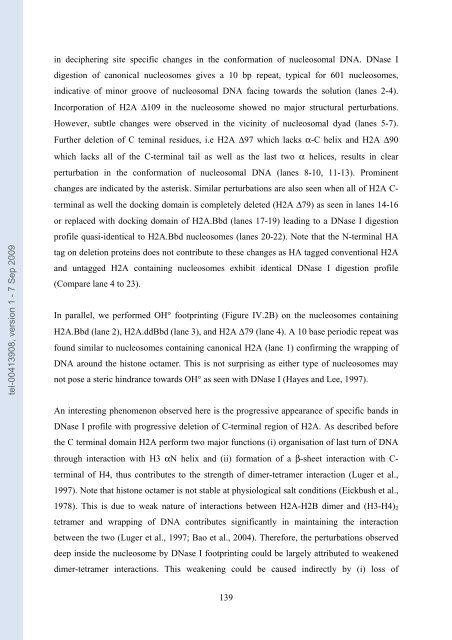Etudes sur le mécanisme de remodelage des nucléosomes par ...
Etudes sur le mécanisme de remodelage des nucléosomes par ...
Etudes sur le mécanisme de remodelage des nucléosomes par ...
You also want an ePaper? Increase the reach of your titles
YUMPU automatically turns print PDFs into web optimized ePapers that Google loves.
tel-00413908, version 1 - 7 Sep 2009<br />
in <strong>de</strong>ciphering site specific changes in the conformation of nuc<strong>le</strong>osomal DNA. DNase I<br />
digestion of canonical nuc<strong>le</strong>osomes gives a 10 bp repeat, typical for 601 nuc<strong>le</strong>osomes,<br />
indicative of minor groove of nuc<strong>le</strong>osomal DNA facing towards the solution (lanes 2-4).<br />
Incorporation of H2A Δ109 in the nuc<strong>le</strong>osome showed no major structural perturbations.<br />
However, subt<strong>le</strong> changes were observed in the vicinity of nuc<strong>le</strong>osomal dyad (lanes 5-7).<br />
Further <strong>de</strong><strong>le</strong>tion of C teminal residues, i.e H2A Δ97 which lacks α-C helix and H2A Δ90<br />
which lacks all of the C-terminal tail as well as the last two α helices, results in c<strong>le</strong>ar<br />
perturbation in the conformation of nuc<strong>le</strong>osomal DNA (lanes 8-10, 11-13). Prominent<br />
changes are indicated by the asterisk. Similar perturbations are also seen when all of H2A C-<br />
terminal as well the docking domain is comp<strong>le</strong>tely <strong>de</strong><strong>le</strong>ted (H2A Δ79) as seen in lanes 14-16<br />
or replaced with docking domain of H2A.Bbd (lanes 17-19) <strong>le</strong>ading to a DNase I digestion<br />
profi<strong>le</strong> quasi-i<strong>de</strong>ntical to H2A.Bbd nuc<strong>le</strong>osomes (lanes 20-22). Note that the N-terminal HA<br />
tag on <strong>de</strong><strong>le</strong>tion proteins does not contribute to these changes as HA tagged conventional H2A<br />
and untagged H2A containing nuc<strong>le</strong>osomes exhibit i<strong>de</strong>ntical DNase I digestion profi<strong>le</strong><br />
(Com<strong>par</strong>e lane 4 to 23).<br />
In <strong>par</strong>al<strong>le</strong>l, we performed OH° footprinting (Figure IV.2B) on the nuc<strong>le</strong>osomes containing<br />
H2A.Bbd (lane 2), H2A.ddBbd (lane 3), and H2A Δ79 (lane 4). A 10 base periodic repeat was<br />
found similar to nuc<strong>le</strong>osomes containing canonical H2A (lane 1) confirming the wrapping of<br />
DNA around the histone octamer. This is not <strong>sur</strong>prising as either type of nuc<strong>le</strong>osomes may<br />
not pose a steric hindrance towards OH° as seen with DNase I (Hayes and Lee, 1997).<br />
An interesting phenomenon observed here is the progressive appearance of specific bands in<br />
DNase I profi<strong>le</strong> with progressive <strong>de</strong><strong>le</strong>tion of C-terminal region of H2A. As <strong>de</strong>scribed before<br />
the C terminal domain H2A perform two major functions (i) organisation of last turn of DNA<br />
through interaction with H3 αN helix and (ii) formation of a β-sheet interaction with C-<br />
terminal of H4, thus contributes to the strength of dimer-tetramer interaction (Luger et al.,<br />
1997). Note that histone octamer is not stab<strong>le</strong> at physiological salt conditions (Eickbush et al.,<br />
1978). This is due to weak nature of interactions between H2A-H2B dimer and (H3-H4)2<br />
tetramer and wrapping of DNA contributes significantly in maintaining the interaction<br />
between the two (Luger et al., 1997; Bao et al., 2004). Therefore, the perturbations observed<br />
<strong>de</strong>ep insi<strong>de</strong> the nuc<strong>le</strong>osome by DNase I footprinting could be largely attributed to weakened<br />
dimer-tetramer interactions. This weakening could be caused indirectly by (i) loss of<br />
139

















